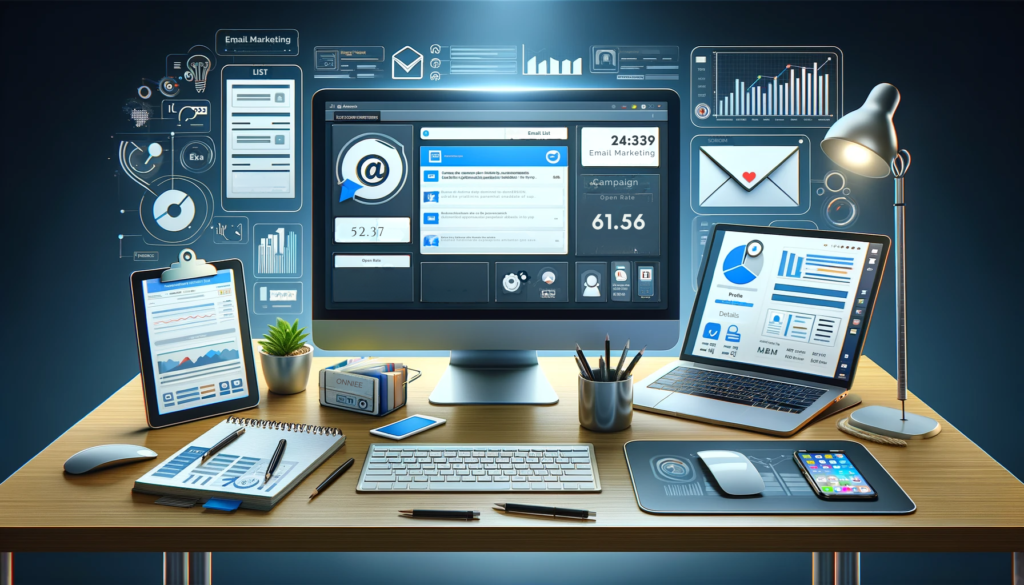
Welcome to the world of email marketing! In the fast-paced realm of digital marketing, email marketing has emerged as a powerful tool for businesses to connect with their audience. But what exactly is email marketing?
Email marketing is a form of direct marketing that leverages the power of promotional emails to reach potential customers and build relationships. It is a key component of marketing automation, allowing businesses to automate their marketing efforts and nurture leads for increased sales and brand awareness.
Did you know that the first email was sent way back in 1971? Since then, email marketing has evolved into a dynamic and essential channel for businesses of all sizes. Whether you are a startup looking to generate leads or an established brand nurturing customer relationships, email marketing plays a vital role in your overall marketing strategy.
With email marketing, you have the opportunity to engage with your audience on a personal level, driving traffic to your website, or even social media platforms. You can also run A/B tests to optimize your emails, ensuring that you are delivering the most compelling content to your audience.
However, like any marketing strategy, email marketing has its challenges. With crowded inboxes and the rise of spam filters, it can be difficult to make your emails stand out. Consistent engagement is key to avoid high unopened rates and unsubscribes.
Key Takeaways:
- Email marketing is a powerful form of digital marketing that uses promotional emails to connect with your audience.
- It is an integral part of marketing automation, allowing businesses to nurture leads and increase brand awareness.
- Email marketing provides opportunities for relationship-building, driving traffic, and running A/B tests for optimization.
- Challenges in email marketing include standing out in crowded inboxes and maintaining consistent engagement.
- By understanding the power of email marketing and overcoming its challenges, you can effectively reach your target audience and achieve your marketing goals.
Advantages of Email Marketing
Email marketing is a powerful tool that provides several advantages for businesses. By leveraging this strategy, you can effectively build relationships with your customers, drive traffic to your website or social media platforms, and optimize your marketing efforts through A/B tests. Additionally, email marketing offers insights into email deliverability and engagement rates, allowing you to refine your campaigns and maximize results.
Building strong relationships with your customers is essential for long-term success. Email marketing enables you to establish personal connections by delivering targeted messages directly to their inboxes. By providing valuable content, personalized offers, and timely updates, you can nurture trust and loyalty with your audience.
Driving traffic to your website or social media platforms is vital for expanding your online presence and increasing conversions. With email marketing, you can strategically direct subscribers to specific landing pages or blog posts, encouraging them to take action and explore more of your offerings.
A/B testing is an indispensable feature of email marketing that allows you to experiment with different subject lines, calls to action, and content layouts. By analyzing the performance of each variation, you can identify what resonates best with your audience and optimize your campaigns accordingly. This iterative process ensures continuous growth and improvement.
Another advantage of email marketing is gaining insights into email deliverability and engagement rates. By monitoring open rates, click-through rates, and other metrics, you can assess the effectiveness of your campaigns and make data-driven decisions. This valuable information enables you to refine your targeting, content, and overall strategy for better engagement and higher conversion rates.
| Advantages of Email Marketing |
|---|
| Relationship building |
| Driving traffic to websites or social media platforms |
| A/B tests for optimization |
| Email deliverability insights |
| Engagement measurement |
Overall, email marketing provides numerous benefits that can significantly impact your business’s growth and success. It empowers you to establish meaningful relationships, drive traffic, optimize campaigns through A/B testing, and gain valuable insights for continuous improvement. By leveraging these advantages effectively, you can unlock the full potential of email marketing and achieve remarkable results.
Disadvantages of Email Marketing

Email marketing undoubtedly offers numerous benefits for businesses. However, it also comes with its fair share of challenges and disadvantages. Let’s explore some of the potential drawbacks that you need to be aware of when implementing an email marketing strategy.
Crowded Inboxes and Spam Filters
In today’s digital age, we all receive countless emails on a daily basis, leading to overcrowded inboxes. As a result, it becomes increasingly difficult for your emails to stand out and capture your audience’s attention. Moreover, spam filters have become more sophisticated in identifying and redirecting promotional emails. This means that even if your content is valuable and relevant, it might still end up in the spam folder.
Email Size and Loading Times
Another challenge with email marketing is the size of the emails themselves. Large email sizes can result in slow loading times, causing frustration for recipients. If customers have to wait too long for your email to open, they may lose interest and delete it without even reading the content. Therefore, it’s crucial to optimize your email size and ensure fast loading times.
Competition for Attention
With the increasing popularity of email marketing, the competition for attention in your audience’s inbox is fierce. Your emails are not only competing with other businesses but also with personal emails and various online subscriptions. To cut through the clutter, you need strong copywriting skills and creative tactics that differentiate your emails and make them irresistible to open and engage with.
Engagement and Retention
Engaging your audience and keeping them interested in your email content over time is a continuous challenge. High unopened rates and unsubscribes are common pitfalls that businesses face. To overcome these hurdles, it’s essential to deliver compelling and relevant content consistently. Tailoring your emails to specific segments of your audience can also improve engagement and retention rates.
In summary, while email marketing is a powerful tool for businesses, it’s crucial to acknowledge the potential disadvantages as well. By addressing issues such as crowded inboxes, spam filters, email size, competition, and engagement, you can enhance the effectiveness of your email marketing campaigns and build strong connections with your target audience.
Types of Email Marketing
When it comes to email marketing, there are various types of emails that serve different purposes to engage your audience and drive results. Let’s explore the different types of email marketing strategies you can implement:
Welcome Emails
Welcome emails are the perfect opportunity to make a positive first impression on your new subscribers. They introduce potential customers to your business and often offer trials, bonuses, or exclusive discounts to encourage further engagement.
Newsletter Emails
Newsletter emails are a great way to keep your audience informed about new products or services, industry updates, and relevant content. These emails typically include articles, blogs, customer reviews, and features that showcase your brand’s expertise.
Lead Nurturing Emails
By sending a series of lead nurturing emails, you can guide your audience through their buyer’s journey, from consideration to purchase. These emails are personalized and tailored to specific audience segments, with the goal of building trust, addressing pain points, and ultimately converting leads into customers.
Confirmation Emails
Confirmation emails provide peace of mind to your subscribers, assuring them that their information has been successfully received. These emails can also include additional actions for recipients to take, such as verifying their email address or exploring related products.
Dedicated Emails
Dedicated emails are targeted at specific segments of your email list based on various criteria, such as demographics, interests, or purchase history. These customized emails allow you to deliver highly relevant content and offers to specific subsets of your audience, maximizing engagement and conversions.
Announcement Emails
Announcement emails are perfect for promoting upcoming events, new product launches, or major announcements. These emails generate excitement and anticipation among your subscribers, encouraging them to take action and participate in your latest offerings.
Generic Marketing Emails
Generic marketing emails are designed to maintain awareness and keep your brand top of mind. These emails may include updates on company news, general promotions, or teasers for upcoming offerings. They are an effective way to nurture relationships with your audience and stay connected between major campaigns
Feedback Emails
Feedback emails provide valuable insights into customer opinions and experiences. By actively seeking feedback from your audience, you can gather valuable information on how to improve your products, services, or overall customer experience.
Holiday Emails
Holiday emails are a festive way to engage your audience during special occasions and seasonal events. These emails often include holiday-themed promotions, exclusive discounts, and seasonal greetings to drive sales and foster customer loyalty.
As you can see, there are various types of email marketing that cater to different stages of the customer journey and serve diverse purposes. By leveraging these email strategies effectively, you can engage your audience, nurture relationships, and drive conversions for your business.
Tips for Building Your Email Marketing List
Building an email marketing list requires a strategic approach. In order to maximize the effectiveness of your email campaigns, it is important to follow certain best practices. Here are some valuable tips to help you build an email marketing list that will yield results:
1. Encourage Opt-In Subscriptions with Lead Magnets
Instead of purchasing email lists, focus on encouraging people to willingly opt into receiving your emails. Offer valuable lead magnets such as exclusive content, discounts, or free resources to entice potential subscribers. This ensures that you have an engaged audience who is genuinely interested in your brand and increases the likelihood of conversion.
2. Adhere to Legal Requirements and Email Regulations
Respecting legal requirements and email regulations is crucial to building a reliable and credible email marketing list. Familiarize yourself with the laws and regulations specific to your location and the locations of your subscribers. This includes obtaining proper consent and providing clear information about the purpose of your emails.
3. Use Email Marketing as a Conversation
Don’t treat your email marketing as a one-way communication channel. Instead, strive to create a conversation with your subscribers. Personalize your emails based on their preferences, interests, and previous interactions. This helps to establish a connection with your audience and makes them feel valued.
4. Segment Your Email List for Targeted Content
Segmentation allows you to divide your email list into specific groups based on factors such as demographics, purchase history, or engagement. This enables you to send targeted content that is relevant to each segment, increasing engagement and conversion rates. Personalized emails have been shown to yield higher open rates and click-through rates.
5. Find the Right Balance in Email Frequency
While consistent communication is important, bombarding your subscribers with emails can lead to email fatigue and increased unsubscribe rates. Find the right balance and frequency of emails that suits your audience. Regularly analyze the engagement metrics to determine the optimal email frequency for your subscribers.
Structure and Design for Effective Marketing Emails
The structure and design of your marketing emails can greatly impact their effectiveness in engaging your audience and driving conversions. By following best practices and utilizing key elements, you can create compelling emails that capture attention and encourage action.
Utilize the Inverted Pyramid Model
The inverted pyramid model is a widely recognized approach to structuring email content. It involves placing the most important information at the top of the email, followed by supporting details and a clear call to action. By organizing your email in this way, you quickly grab readers’ attention and ensure they understand the main message even if they only read the opening lines.
Enhance Engagement with Visuals
Visual elements, such as images and videos, can significantly boost engagement and make your emails more memorable. Including relevant visuals that align with your brand and message adds visual interest and helps convey information more effectively. For example, you could use product images to showcase new offerings or testimonials to build trust and credibility.
Personalize and Make It Relevant
Personalization is key to capturing your audience’s attention. Tailor your emails to address recipients by their name, purchase history, or other relevant data points. Additionally, ensure that your content is highly relevant to each recipient’s interests and needs. Segment your email list and craft targeted messages that resonate with specific groups to increase engagement and drive conversion.
Consistency and Branding
It is essential to maintain consistency with your brand across all customer touchpoints, including your marketing emails. Use the same visual elements, fonts, colors, and tone of voice that align with your overall branding strategy. Consistency builds trust, strengthens brand recognition, and reinforces your messaging across different channels.
Optimize for Conversion
Your marketing emails should make it easy for recipients to take the desired action. Optimize your emails for different devices, ensuring they are mobile-friendly and load quickly. Use clear and compelling call-to-action (CTA) buttons that guide recipients towards the desired conversion, whether it’s making a purchase, signing up for an event, or downloading a resource.
By structuring your marketing emails effectively, incorporating visuals, personalizing content, maintaining consistency with your brand, and optimizing for conversion, you can create powerful emails that engage your audience, drive action, and ultimately boost your business’s success.
Timing and Analytics for Email Marketing Success

Timing plays a crucial role in the success of your email marketing campaigns. By strategically timing your automated email campaigns based on specific events or user actions, you can increase the chances of capturing your audience’s attention and driving engagement.
To maintain and guide customers through the marketing funnel, nurture sequences are an effective strategy. These sequences involve sending a series of emails that are timed and tailored to provide valuable content at each stage of the customer journey. By nurturing your leads, you can build trust, encourage conversions, and increase customer loyalty.
Data analysis and A/B testing are essential for optimizing your email campaigns. Regularly track and analyze key metrics such as open rates, click-through rates, and conversion rates to gain insights into what is working and what can be improved. A/B testing allows you to experiment with different elements such as subject lines, call-to-action buttons, and visuals to identify the most effective approach for engaging your audience.
There are various email marketing tools available to streamline your campaigns and gain valuable insights. These tools offer advanced features such as designing personalized emails, managing contact lists, sending automated emails, and monitoring campaign performance. Leverage the power of these tools to enhance your email marketing efforts and drive better results.
| Email Marketing Strategies | Benefits |
|---|---|
| Strategic Timing | Increase open and click-through rates, improve audience engagement |
| Nurture Sequences | Build relationships, guide customers through the marketing funnel, increase conversions |
| Data Analysis | Optimize email campaigns, gain insights into audience preferences |
| A/B Testing | Identify the most effective elements and optimize campaign performance |
| Email Marketing Tools | Simplify campaign management, personalize content, monitor performance |
Conclusion
In the world of digital marketing, email marketing is a powerful tool that allows businesses to connect with customers and drive sales. By leveraging the benefits of email marketing, such as relationship building and driving traffic, businesses can effectively engage their target audience. However, it is important to be aware of the challenges that come with email marketing, such as standing out in crowded inboxes.
To optimize your email marketing campaigns, it is crucial to follow best practices. Start by structuring your emails effectively using the inverted pyramid model, with a clear headline, supporting information, and a compelling call to action. Personalize your content to make it relevant and interesting to your audience, and ensure consistency with your branding across all customer touchpoints.
Data analysis plays a crucial role in email marketing optimization. Regularly analyze your campaign data to gain insights into audience engagement and make data-driven decisions. Conduct A/B testing to refine your email strategies and improve audience response. Utilize email marketing tools that offer advanced features to streamline your campaign management and monitor performance.
With the right approach, email marketing can be a highly effective tool for audience engagement and driving business growth. By implementing effective strategies, personalizing content, and utilizing data analysis, you can maximize the impact of your email marketing campaigns and achieve your digital marketing objectives.
FAQ
What is email marketing?
Email marketing is a form of digital marketing that uses email to promote products or services. It is a direct marketing technique that can be integrated into marketing automation efforts to make customers aware of new offerings and build relationships.
What are the advantages of email marketing?
Email marketing offers several advantages for businesses. It allows for the building of relationships with customers, driving traffic to websites or social media platforms, and conducting A/B tests to optimize subject lines or calls to action. Email marketing also provides insights into email deliverability and engagement rates.
What are the disadvantages of email marketing?
The disadvantages of email marketing include challenges such as standing out in crowded inboxes, dealing with spam filters, slow loading times due to large email sizes, and high competition for attention. Engaging subscribers continuously is crucial to avoid high unopened rates and unsubscribes.
What are the different types of email marketing?
There are various types of email marketing that serve different purposes. These include welcome emails, newsletter emails, lead nurturing emails, confirmation emails, dedicated emails, announcement emails, generic marketing emails, feedback emails, and holiday emails.
How can I build my email marketing list?
Building an email marketing list requires a strategic approach. Avoid buying email lists and instead focus on encouraging people to opt into receiving emails through lead magnets. Adhere to email regulations and legal requirements based on your location and subscribers’ locations. Use email marketing to have conversations with customers and personalize content. List segmentation helps customize content based on specific audiences, increasing engagement and revenue. Balancing the frequency of emails is important to avoid email fatigue.
What should be the structure and design of marketing emails?
Marketing emails should be structured using the inverted pyramid model, with a clear headline, supporting information, and a call to action. Visuals such as images and videos can be used to boost engagement. Personalization and relevance to the audience are key to capturing attention. Emails should be on-brand and consistent with other customer touchpoints to build trust. Optimizing emails for different devices and using clear CTAs makes conversion easy.
How important is timing and analytics in email marketing?
Timing is crucial in email marketing. Automated email campaigns can be timed strategically based on specific events or user actions. Nurture sequences help maintain engagement and guide customers through the marketing funnel. Regular data analysis and A/B testing are essential for optimizing email campaigns. Email marketing tools offer advanced features for designing personalized emails, managing contact lists, sending automated emails, and monitoring campaign performance.
How can I optimize my email marketing campaigns?
To optimize your email marketing campaigns, follow best practices in structuring emails effectively, personalizing content, analyzing data, and engaging your target audience. Regular data analysis and A/B testing are essential for optimizing email campaigns and engaging your target audience.


